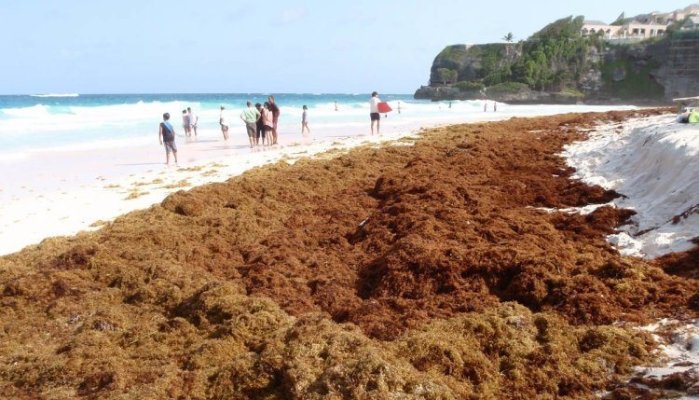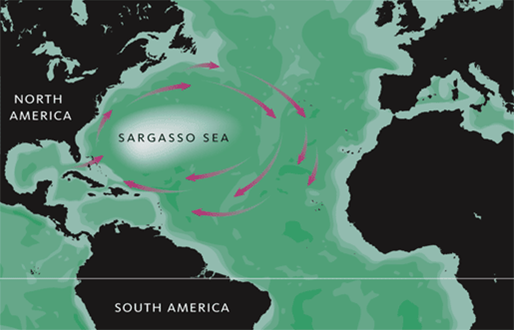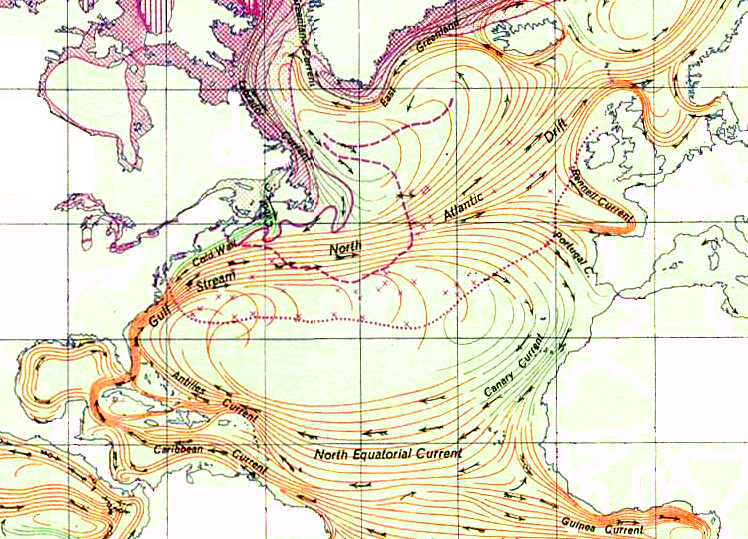karimwassef
Active member
If you've been to the Caribbean in the last couple of years, you've probably slogged through feet deep stinky Sargassum overflow on the beaches and a hot thick soup of Sargassum float as you get into the blue.


http://www.newsweek.com/2015/07/10/sargassum-ruining-beaches-texas-tobago-347735.html
I was personally both amazed and disgusted at the stuff but it set me on a path of learning more about the stuff.
https://en.wikipedia.org/wiki/Sargassum
The "Sargasso" sea is basically a massive floating island mass of this seaweed in the Atlantic

It's bounded by current instead of land from Bermuda and almost to Africa. The circulation of currents around it keep it contained most of the time.

https://en.wikipedia.org/wiki/Sargasso_Sea
It's the only "island" defined by water flow this way and it's so large and thick that early explorers thought it was land. It's roughly the size of Australia. Scientists believe that violent storms and weather patterns break off parts of this island and that's what causes the mess in the Caribbean.
Ok. So who cares?
I'm fascinated by the role of the Sargassum as an incubator for plankton and other juvenile life. While snorkeling in and round the floats in Cancun this summer, that really came into focus. The seaweed mass is frothing with life if you take a minute to look. Most interesting is the almost invisible soup that drains from it and around it when you pull it out of the water.
This seaweed has floating sacs that keep it afloat - so it acts like a kiddie float that corrals and protects the babies while giving shelter from airborne predators too. The leaves have a shape that allows for plenty of space between sections without being easily crushed (like other algae). It also traps heat so well that there is a significant temperature gradient between the mass and the water below and around it. It's in the perfect Goldilocks zone where plankton can thrive with abundant sources of heat, light and nutrients with protection and control.
So - a Sargassum biotope is very intriguing on many fronts! I couldn't find any postings on anyone successfully doing this - hence this post looking for help. The life in a Sargassum float is amazing! My kids and I counted almost 100 life forms. From frogfish to swimming crabs to sea horses and juvenile forms of eels, jacks, puffers, filefish...
I use Chaeto in my refugium and it works well to keep my glass and peppermint shrimp safe and spawning, but it doesn't naturally float or have the construction that Sargassum leaves have to incubate baby fauna. The idea is to attach this as a safe haven away from my main reef and act as a life pump into the DT. This is what the Saragasso sea DOES in nature. It's a protected space where plankton can thrive but still be controlled and that is exactly what I'm interested in recreating.
Ok - enough gushing over a seaweed (wife thinks I'm nuts already) - what do you think?


http://www.newsweek.com/2015/07/10/sargassum-ruining-beaches-texas-tobago-347735.html
I was personally both amazed and disgusted at the stuff but it set me on a path of learning more about the stuff.
https://en.wikipedia.org/wiki/Sargassum
The "Sargasso" sea is basically a massive floating island mass of this seaweed in the Atlantic

It's bounded by current instead of land from Bermuda and almost to Africa. The circulation of currents around it keep it contained most of the time.

https://en.wikipedia.org/wiki/Sargasso_Sea
It's the only "island" defined by water flow this way and it's so large and thick that early explorers thought it was land. It's roughly the size of Australia. Scientists believe that violent storms and weather patterns break off parts of this island and that's what causes the mess in the Caribbean.
Ok. So who cares?
I'm fascinated by the role of the Sargassum as an incubator for plankton and other juvenile life. While snorkeling in and round the floats in Cancun this summer, that really came into focus. The seaweed mass is frothing with life if you take a minute to look. Most interesting is the almost invisible soup that drains from it and around it when you pull it out of the water.
This seaweed has floating sacs that keep it afloat - so it acts like a kiddie float that corrals and protects the babies while giving shelter from airborne predators too. The leaves have a shape that allows for plenty of space between sections without being easily crushed (like other algae). It also traps heat so well that there is a significant temperature gradient between the mass and the water below and around it. It's in the perfect Goldilocks zone where plankton can thrive with abundant sources of heat, light and nutrients with protection and control.
So - a Sargassum biotope is very intriguing on many fronts! I couldn't find any postings on anyone successfully doing this - hence this post looking for help. The life in a Sargassum float is amazing! My kids and I counted almost 100 life forms. From frogfish to swimming crabs to sea horses and juvenile forms of eels, jacks, puffers, filefish...
I use Chaeto in my refugium and it works well to keep my glass and peppermint shrimp safe and spawning, but it doesn't naturally float or have the construction that Sargassum leaves have to incubate baby fauna. The idea is to attach this as a safe haven away from my main reef and act as a life pump into the DT. This is what the Saragasso sea DOES in nature. It's a protected space where plankton can thrive but still be controlled and that is exactly what I'm interested in recreating.
Ok - enough gushing over a seaweed (wife thinks I'm nuts already) - what do you think?
